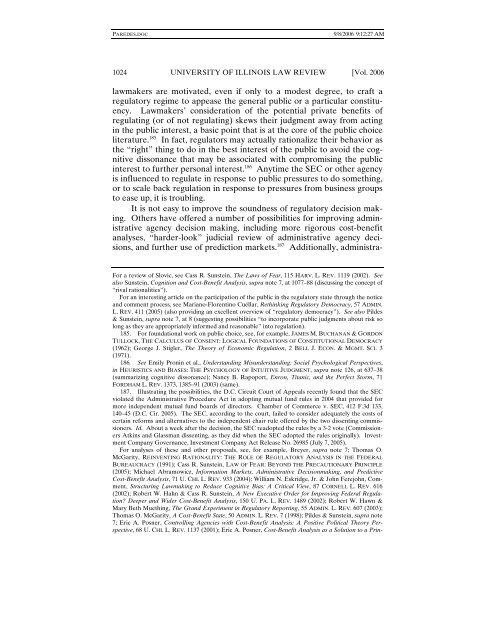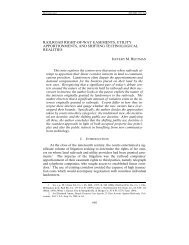on the decision to regulate hedge funds - University of Illinois Law ...
on the decision to regulate hedge funds - University of Illinois Law ...
on the decision to regulate hedge funds - University of Illinois Law ...
Create successful ePaper yourself
Turn your PDF publications into a flip-book with our unique Google optimized e-Paper software.
PAREDES.DOC<br />
9/8/2006 9:12:27 AM<br />
1024 UNIVERSITY OF ILLINOIS LAW REVIEW [Vol. 2006<br />
lawmakers are motivated, even if <strong>on</strong>ly <strong>to</strong> a modest degree, <strong>to</strong> craft a<br />
regula<strong>to</strong>ry regime <strong>to</strong> appease <strong>the</strong> general public or a particular c<strong>on</strong>stituency.<br />
<strong>Law</strong>makers’ c<strong>on</strong>siderati<strong>on</strong> <strong>of</strong> <strong>the</strong> potential private benefits <strong>of</strong><br />
regulating (or <strong>of</strong> not regulating) skews <strong>the</strong>ir judgment away from acting<br />
in <strong>the</strong> public interest, a basic point that is at <strong>the</strong> core <strong>of</strong> <strong>the</strong> public choice<br />
literature. 185 In fact, regula<strong>to</strong>rs may actually rati<strong>on</strong>alize <strong>the</strong>ir behavior as<br />
<strong>the</strong> “right” thing <strong>to</strong> do in <strong>the</strong> best interest <strong>of</strong> <strong>the</strong> public <strong>to</strong> avoid <strong>the</strong> cognitive<br />
diss<strong>on</strong>ance that may be associated with compromising <strong>the</strong> public<br />
interest <strong>to</strong> fur<strong>the</strong>r pers<strong>on</strong>al interest. 186 Anytime <strong>the</strong> SEC or o<strong>the</strong>r agency<br />
is influenced <strong>to</strong> <strong>regulate</strong> in resp<strong>on</strong>se <strong>to</strong> public pressures <strong>to</strong> do something,<br />
or <strong>to</strong> scale back regulati<strong>on</strong> in resp<strong>on</strong>se <strong>to</strong> pressures from business groups<br />
<strong>to</strong> ease up, it is troubling.<br />
It is not easy <strong>to</strong> improve <strong>the</strong> soundness <strong>of</strong> regula<strong>to</strong>ry decisi<strong>on</strong> making.<br />
O<strong>the</strong>rs have <strong>of</strong>fered a number <strong>of</strong> possibilities for improving administrative<br />
agency decisi<strong>on</strong> making, including more rigorous cost-benefit<br />
analyses, “harder-look” judicial review <strong>of</strong> administrative agency decisi<strong>on</strong>s,<br />
and fur<strong>the</strong>r use <strong>of</strong> predicti<strong>on</strong> markets. 187 Additi<strong>on</strong>ally, administra-<br />
For a review <strong>of</strong> Slovic, see Cass R. Sunstein, The <strong>Law</strong>s <strong>of</strong> Fear, 115 HARV. L. REV. 1119 (2002). See<br />
also Sunstein, Cogniti<strong>on</strong> and Cost-Benefit Analysis, supra note 7, at 1077–88 (discussing <strong>the</strong> c<strong>on</strong>cept <strong>of</strong><br />
“rival rati<strong>on</strong>alities”).<br />
For an interesting article <strong>on</strong> <strong>the</strong> participati<strong>on</strong> <strong>of</strong> <strong>the</strong> public in <strong>the</strong> regula<strong>to</strong>ry state through <strong>the</strong> notice<br />
and comment process, see Mariano-Florentino Cuéllar, Rethinking Regula<strong>to</strong>ry Democracy, 57 ADMIN.<br />
L. REV. 411 (2005) (also providing an excellent overview <strong>of</strong> “regula<strong>to</strong>ry democracy”). See also Pildes<br />
& Sunstein, supra note 7, at 8 (suggesting possibilities “<strong>to</strong> incorporate public judgments about risk so<br />
l<strong>on</strong>g as <strong>the</strong>y are appropriately informed and reas<strong>on</strong>able” in<strong>to</strong> regulati<strong>on</strong>).<br />
185. For foundati<strong>on</strong>al work <strong>on</strong> public choice, see, for example, JAMES M. BUCHANAN & GORDON<br />
TULLOCK, THE CALCULUS OF CONSENT: LOGICAL FOUNDATIONS OF CONSTITUTIONAL DEMOCRACY<br />
(1962); George J. Stigler, The Theory <strong>of</strong> Ec<strong>on</strong>omic Regulati<strong>on</strong>, 2 BELL J. ECON. & MGMT. SCI. 3<br />
(1971).<br />
186. See Emily Pr<strong>on</strong>in et al., Understanding Misunderstanding: Social Psychological Perspectives,<br />
in HEURISTICS AND BIASES: THE PSYCHOLOGY OF INTUITIVE JUDGMENT, supra note 126, at 637–38<br />
(summarizing cognitive diss<strong>on</strong>ance); Nancy B. Rapoport, Enr<strong>on</strong>, Titanic, and <strong>the</strong> Perfect S<strong>to</strong>rm, 71<br />
FORDHAM L. REV. 1373, 1385–91 (2003) (same).<br />
187. Illustrating <strong>the</strong> possibilities, <strong>the</strong> D.C. Circuit Court <strong>of</strong> Appeals recently found that <strong>the</strong> SEC<br />
violated <strong>the</strong> Administrative Procedure Act in adopting mutual fund rules in 2004 that provided for<br />
more independent mutual fund boards <strong>of</strong> direc<strong>to</strong>rs. Chamber <strong>of</strong> Commerce v. SEC, 412 F.3d 133,<br />
140–45 (D.C. Cir. 2005). The SEC, according <strong>to</strong> <strong>the</strong> court, failed <strong>to</strong> c<strong>on</strong>sider adequately <strong>the</strong> costs <strong>of</strong><br />
certain reforms and alternatives <strong>to</strong> <strong>the</strong> independent chair rule <strong>of</strong>fered by <strong>the</strong> two dissenting commissi<strong>on</strong>ers.<br />
Id. About a week after <strong>the</strong> decisi<strong>on</strong>, <strong>the</strong> SEC readopted <strong>the</strong> rules by a 3-2 vote (Commissi<strong>on</strong>ers<br />
Atkins and Glassman dissenting, as <strong>the</strong>y did when <strong>the</strong> SEC adopted <strong>the</strong> rules originally). Investment<br />
Company Governance, Investment Company Act Release No. 26985 (July 7, 2005).<br />
For analyses <strong>of</strong> <strong>the</strong>se and o<strong>the</strong>r proposals, see, for example, Breyer, supra note 7; Thomas O.<br />
McGarity, REINVENTING RATIONALITY: THE ROLE OF REGULATORY ANALYSIS IN THE FEDERAL<br />
BUREAUCRACY (1991); Cass R. Sunstein, LAW OF FEAR: BEYOND THE PRECAUTIONARY PRINCIPLE<br />
(2005); Michael Abramowicz, Informati<strong>on</strong> Markets, Administrative Decisi<strong>on</strong>making, and Predictive<br />
Cost-Benefit Analysis, 71 U. CHI. L. REV. 933 (2004); William N. Eskridge, Jr. & John Ferejohn, Comment,<br />
Structuring <strong>Law</strong>making <strong>to</strong> Reduce Cognitive Bias: A Critical View, 87 CORNELL L. REV. 616<br />
(2002); Robert W. Hahn & Cass R. Sunstein, A New Executive Order for Improving Federal Regulati<strong>on</strong>?<br />
Deeper and Wider Cost-Benefit Analysis, 150 U. PA. L. REV. 1489 (2002); Robert W. Hawn &<br />
Mary Beth Muething, The Grand Experiment in Regula<strong>to</strong>ry Reporting, 55 ADMIN. L. REV. 607 (2003);<br />
Thomas O. McGarity, A Cost-Benefit State, 50 ADMIN. L. REV. 7 (1998); Pildes & Sunstein, supra note<br />
7; Eric A. Posner, C<strong>on</strong>trolling Agencies with Cost-Benefit Analysis: A Positive Political Theory Perspective,<br />
68 U. CHI. L. REV. 1137 (2001); Eric A. Posner, Cost-Benefit Analysis as a Soluti<strong>on</strong> <strong>to</strong> a Prin-




